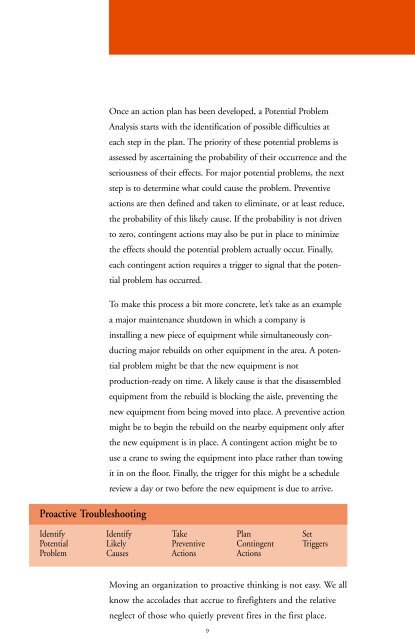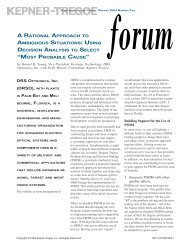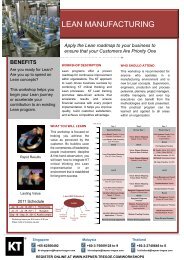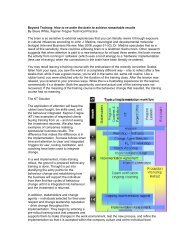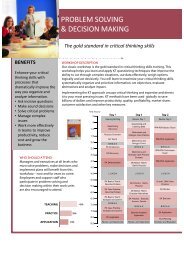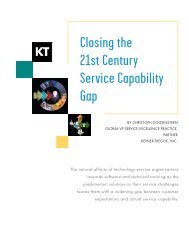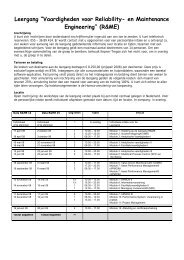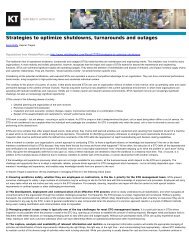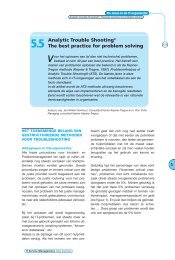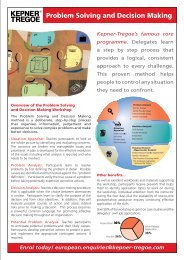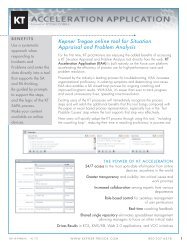Troubleshooting the Troubleshooting System - Kepner-Tregoe
Troubleshooting the Troubleshooting System - Kepner-Tregoe
Troubleshooting the Troubleshooting System - Kepner-Tregoe
You also want an ePaper? Increase the reach of your titles
YUMPU automatically turns print PDFs into web optimized ePapers that Google loves.
Proactive <strong>Troubleshooting</strong><br />
Identify<br />
Potential<br />
Problem<br />
Once an action plan has been developed, a Potential Problem<br />
Analysis starts with <strong>the</strong> identification of possible difficulties at<br />
each step in <strong>the</strong> plan. The priority of <strong>the</strong>se potential problems is<br />
assessed by ascertaining <strong>the</strong> probability of <strong>the</strong>ir occurrence and <strong>the</strong><br />
seriousness of <strong>the</strong>ir effects. For major potential problems, <strong>the</strong> next<br />
step is to determine what could cause <strong>the</strong> problem. Preventive<br />
actions are <strong>the</strong>n defined and taken to eliminate, or at least reduce,<br />
<strong>the</strong> probability of this likely cause. If <strong>the</strong> probability is not driven<br />
to zero, contingent actions may also be put in place to minimize<br />
<strong>the</strong> effects should <strong>the</strong> potential problem actually occur. Finally,<br />
each contingent action requires a trigger to signal that <strong>the</strong> potential<br />
problem has occurred.<br />
To make this process a bit more concrete, let’s take as an example<br />
a major maintenance shutdown in which a company is<br />
installing a new piece of equipment while simultaneously conducting<br />
major rebuilds on o<strong>the</strong>r equipment in <strong>the</strong> area. A potential<br />
problem might be that <strong>the</strong> new equipment is not<br />
production-ready on time. A likely cause is that <strong>the</strong> disassembled<br />
equipment from <strong>the</strong> rebuild is blocking <strong>the</strong> aisle, preventing <strong>the</strong><br />
new equipment from being moved into place. A preventive action<br />
might be to begin <strong>the</strong> rebuild on <strong>the</strong> nearby equipment only after<br />
<strong>the</strong> new equipment is in place. A contingent action might be to<br />
use a crane to swing <strong>the</strong> equipment into place ra<strong>the</strong>r than towing<br />
it in on <strong>the</strong> floor. Finally, <strong>the</strong> trigger for this might be a schedule<br />
review a day or two before <strong>the</strong> new equipment is due to arrive.<br />
Identify<br />
Likely<br />
Causes<br />
Take<br />
Preventive<br />
Actions<br />
Moving an organization to proactive thinking is not easy. We all<br />
know <strong>the</strong> accolades that accrue to firefighters and <strong>the</strong> relative<br />
neglect of those who quietly prevent fires in <strong>the</strong> first place.<br />
9<br />
Plan<br />
Contingent<br />
Actions<br />
Set<br />
Triggers


